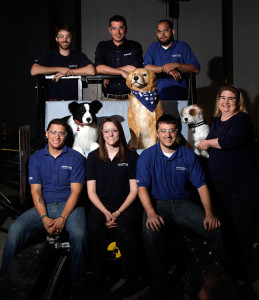2011 Pilot Study: The Center for Pet Safety presents the Pilot Study evidence that launched our mission.
Companies and individuals requesting to receive more information on the full CPS Pilot Study can contact the CPS Public Relations Team at PR@CenterforPetSafety.org.
CPS Founder, Lindsey Wolko (far right) with the MGA Research Team (Manassas, Virginia), (Rear) Patrick, Steve, Dan. (Front) Mike, Tara, Conner – and our beloved crash test dogs!
Canine Automotive Restraint Crashworthiness Testing
The focus of this pilot study is to determine the general effectiveness of canine automotive restraints. Do they prevent injury of the pet? Do they prevent secondary injury to humans in an automobile accident?
Because standardized testing does not exist for this class of pet product, we used a test generally referenced by some canine safety harness manufacturers, the Federal Motor Vehicle Safety Standard (FMVSS) 213 for child restraint systems.
Using FMVSS 213 conditions, CPS tested a control group of readily available canine automotive restraints. The testing was conducted at MGA Research Corporation’s test facility located in Manassas, Virginia. MGA Research also performs testing services for the U.S. Department of Transportation, National Highway Traffic Safety Administration (NHTSA). For the purpose of this initial study, we tested products intended for large dogs, generally 50-85 pounds. (Sample breeds in this size include Poodles, German Shepherds, Irish Setters, Labrador Retrievers, Boxers, and Weimaraners.)
The pilot study was completed using a specially designed crash test dog model weighing 55 lbs. We do not use live animals in our testing.
Results and Analysis: What We Learned
Alarmingly, the pilot study revealed a 100 percent failure rate. None of the harnesses were deemed safe enough to protect both the dog and the humans in the event of an accident.
The slow-motion videos below provide evidence of what happens to a large, harnessed dog in a simulated collision of a car traveling 30 miles per hour. Examples of problems include:
- Extremely low likelihood of survivability for the animal.
- Danger to humans when the dog becomes a missile.
- Choking and/or other bodily harm to the animal when harness materials cinch tightly upon impact.
- Extensive damage to fixtures within the vehicle caused by the projectile animal.
About the harnesses selected for the pilot study
Pet product safety is a concern shared by consumers and manufacturers, and we understand why people want to know the brand names tested in the pilot study conducted by CPS. However, we are not yet in a position to reveal the names of individual products or brand names, and here’s why:
Our primary concern is NOT to attack individual manufacturers for selling well-intentioned products. If we share brands at this early stage in our work, we shift the focus away from what is truly needed: measurable, safe standards that manufacturers can follow for the benefit of consumers.
After these standards are in place, we can then work with manufacturers to guide them as they develop safe, tested products.
In other words, manufacturers are not ignoring safety standards. There simply are no existing standards in place. This is not the fault of the manufacturer. Pet product safety is an emerging issue, and the Center for Pet Safety was formed to address it.
The video content below may be disturbing and is not for children. Viewer discretion is advised.

